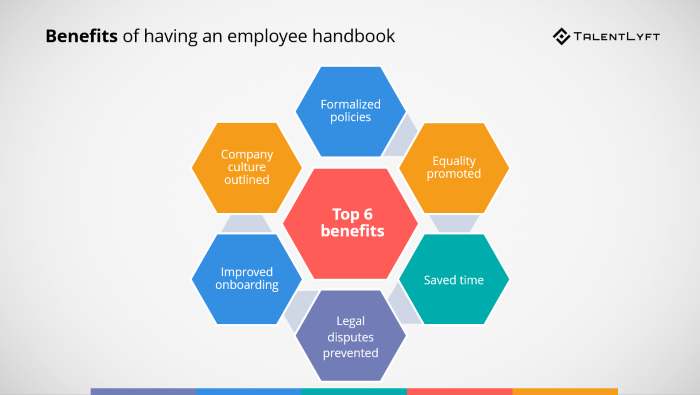
Articles
What Are the Benefits of an Employee Handbook?

Having a well-crafted employee handbook is essential for any business. The company handbook sets expectations, promotes company culture and values, helps ensure compliance with laws and regulations, and serves as an onboarding tool to help new hires get settled in. But what are the benefits of an employee handbook?
From improved communication between management teams and staff to clear policies that protect both employers and employees from legal liability, there's no denying that creating an employee manual offers tangible rewards.
In this blog post, we'll explore what are the benefits of an employee handbook while also examining why it should be implemented in every business environment.
What Are The Benefits of an Employee Handbook?
Employee handbooks provide clear communication and expectations to employees, while also reducing risk and liability.
What are the benefits of an employee handbook? Here are some of them.
Improved Communication
A company employee handbook can help ensure that everyone in the organization is on the same page when it comes to policies, procedures, and expectations. This helps reduce confusion and misunderstanding among employees, which leads to improved communication within the workplace.
Increased Productivity
With a well-crafted, compliant employee handbook in place, there’s less time wasted trying to figure out how things should be done or who’s responsible for what tasks. Everyone knows exactly what their role is and how they should go about doing it — resulting in increased productivity across the board.
Reduced Risk and Liability
Having a comprehensive set of rules and regulations outlined in the staff handbook can help protect your business from potential legal issues later on. It ensures that everyone understands their rights as an employee as well as any applicable laws or regulations related to their job duties. This will prevent costly lawsuits or other liabilities associated with noncompliance or negligence.
Creating a Strong Employee Handbook
Staff handbooks should be tailored to the specific needs of your business. How do you get started with creating an effective employee manual?
Communicate Company Values
The culture of a company can have a huge impact on its success or failure. Therefore, it is important that you define it clearly in your employee handbook as well as communicate it regularly throughout the workplace environment itself. Make sure that you set out core values that everyone has to follow when making decisions or interacting with customers, clients, and colleagues to create consistency across all areas of operation within your business.
Establish Clear Policies and Procedures
A well-crafted employee handbook will clearly outline policies and procedures that employees are expected to follow. This includes everything from dress code to vacation time policies. Make sure all rules are in line with local, state, and federal laws so you don’t find yourself in legal trouble.
Outline Expectations for Employees
The company handbook should include a section outlining what is expected of each individual employee within their role in the company. This could include performance standards they must meet in order to remain employed by your organization.
Be sure that these expectations are reasonable and achievable.

How to Foster Healthy Management-Employee Relationships
A compliant employee handbook is key to fostering good employer-employee relationships. Here are three things you should consider when writing your staff handbook.
Understand Local, State, and Federal Requirements
As a business owner or manager, it’s important to ensure compliance with local, state, and federal regulations that apply to your company. These can include labor laws such as minimum wage requirements, safety regulations, and tax obligations. Be sure to update your employee handbook whenever there are revisions or additions to labor laws.
Develop Protocols for Reporting Harassment or Discrimination
To protect employees from harassment or discrimination in the workplace, it is essential to develop protocols for reporting incidents of this nature. This should include clear guidelines on how employees should report any issues they may have experienced or witnessed, as well as what steps to take once an incident has been reported.
Employers must provide regular training on these procedures so that everyone is aware of their rights under the law.
Establish Paid Time Off Policies
Establishing paid time off (PTO) policy is an important part of creating a positive work environment for employees while ensuring compliance with applicable employment laws. PTO policies should outline how much time off each employee is entitled to based on their position within the company as well as when they are eligible for additional days off due to holidays.
Employers must also consider policies such as sick leave and family medical leave when crafting their PTO policy in order to comply with all relevant laws regarding employee benefits.
Implementing an Employee Handbook in Your Business
Once you have created your employee handbook, it’s important to ensure that all employees receive a copy of it and that managers are trained on how to use the handbook effectively.
Train Managers
Managers need to understand their role when it comes to implementing an employee handbook so they can enforce its rules consistently and fairly across all departments. It's important for them to know what topics are covered in each section of the handbook and what actions should be taken if certain situations arise at work such as harassment or discrimination complaints.
They also need guidance on how best to communicate expectations from both employers and employees alike while maintaining a positive working environment.
Distribute Handbook Copies
It's essential that every employee has access to the latest version of the company's employee handbook so they know exactly what is expected from them during their time at work. Providing copies electronically via email or through an online portal makes sure everyone receives their copy quickly while waiting for the printed version.
Schedule Policy Reviews
As businesses grow, change is inevitable. New laws and regulations come into effect, job roles evolve, and team dynamics shift. Therefore, updating your company's policy manual regularly is necessary in order to stay compliant with local, state, and federal requirements while keeping up with internal changes as well.
Conclusion
What are the benefits of an employee handbook?
An employee manual can help you create a more efficient and organized workplace while ensuring compliance with regulations and laws. Once your handbook is in place, implementing it in your business will ensure that everyone has access to the same information and policies. This will make onboarding, offboarding, and training experiences much smoother for both employers and employees.
Are you looking for a comprehensive way to document processes and policies, and provide superior onboarding, offboarding, and training experiences? Trainual is the perfect solution! Our easy-to-use platform helps entrepreneurs, founders, managers, and operational leaders grow their businesses quickly with efficient process management.
We make sure that your employees have all of the resources they need to succeed in their roles by providing an employee handbook that outlines company goals and values as well as expectations from both employer and employee. Try us today to see how we can help you streamline operations while giving your team members everything they need for success!
Similar Blog Posts







